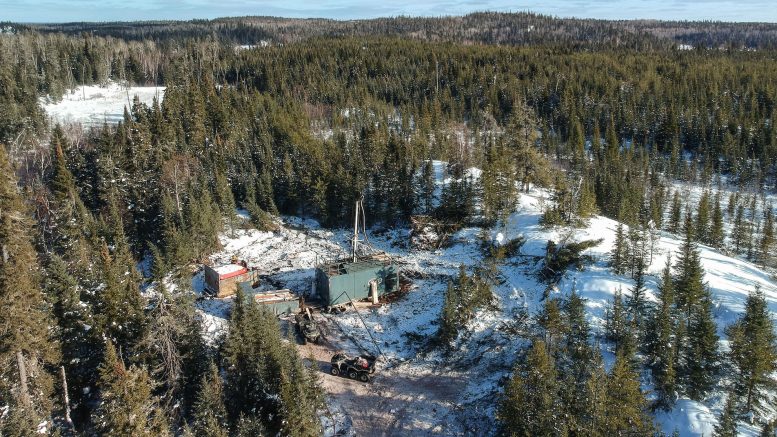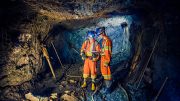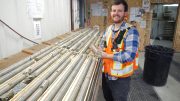In the summer of 1925, the discovery of gold in northwestern Ontario’s Red Lake region triggered the last great gold rush in North America.
At the height of the gold rush, in 1926, more than 3,000 people had converged on the region.
By 1936, Howey Bay, in the heart of Red Lake, was the busiest airport in the world, transporting freight and passengers in and out of the goldfields every 15 minutes.
To date, the area has produced approximately 30 million oz. gold from 29 gold mines.
For the past 30 years, Dale Ginn, founder and chairman of Pacton Gold (TSXV: PAC; US-OTC: PACXF), has led or been part of teams that have been responsible for some of the most prominent gold discoveries in the region and beyond.
“I’ve been working in Central Canada for a long time and have been involved with several exploration and development companies,” Ginn says. “Around two years ago, my team and I were awarded the Quebec Discovery of the Year Golden Hammer award for the Gladiator discovery.”
The high-grade Gladiator gold deposit, located 420 km north northwest of Montreal, is now being mined by Bonterra Resources (TSX: BTR). The deposit contains indicated resources of 743,000 tonnes grading 8.5 grams gold per tonne for 202,000 contained oz. gold and inferred resources of 3.1 million tonnes grading 9.1 grams gold per tonne for 897,000 oz. gold.
Ginn says he has participated in a variety of gold and base metal discoveries, and he has worked with both senior and junior companies such as Goldcorp, which was acquired by Newmont (TSX: NGT; NYSE: NEM), Hudbay Minerals (TSX: HBM; NYSE: HBM) and Harmony Gold (NYSE: HMY).
According to Ginn, his contributions have led to approximately 10 million oz. in resource generation and over $500 million in capital raised for exploration and development projects.
“I lived in Red Lake in the 80s and worked as a geologist for Dickinson Mines, which later became Goldcorp, the owners of the original Red Lake mine,” Ginn says. “I left there just before the mine went on strike, and gold was just under US$400 an ounce. So, it was tough times there.”
At the time, he adds, the company was beginning to discover new high-grade gold zones that, only a few years later, were found to have expanded into massive zones of high-grade mineralization. However, the area remained relatively quiet until a couple of years ago, he says, when Great Bear made its discovery at Dixie.

Field geologist Carly Smythe at Great Bear Resources’ Dixie gold project in Red Lake, Ontario. Credit: Great Bear Resources.
“The key to their success was that the discovery has been in confederation rocks, which used to be considered less prospective than the Balmer series of rocks,” Ginn explains.
Both rock formations, he adds, are around the same age. However, the Balmer Assemblage units have hosted most of the gold produced from the area.
“Gold deposits in the Red Lake area are classified as orogenic gold,” Ginn says. “This type of deposit is characterized by a strong association with deep, crustal-scale fault structures and are largely restricted to brittle-ductile transition zones in the host rocks.”
In 2017, he adds, Pacton entered into several agreements with smaller prospecting companies in the Red Lake region and established several prime positions in the area. Then, around a year later, Great Bear made its Dixie discovery.
“Up until this discovery, most people had focussed on a specific rock type rather than the underlying structures that controlled the mineralization,” Ginn says. “Now, with the find and gold prices where they are, the region has become one of, if not these most, attractive regions in the world for gold discovery again.”
He notes that the large Australian gold producer, Evolution Mining (ASX: EVN), has moved into the area, Battle North Gold (TSX: BNAU; US-OTC: BNAUF), formerly called Rubicon Minerals, is advancing its Bateman gold project, and Pure Gold Mining (TSXV: PGM; LSE: PUR) is building its Madsen mine.
“There is now a re-focus on the area, and rather than excluding certain rock types, companies are exploring pretty much the whole greenstone belt, which also feeds into the Ojibwe area to the east of Red Lake,” Ginn says. “This area has already been fully staked.”
A large part of the greenstone belt has been underexplored for many years, he adds, and so the area represents a significant opportunity for junior mining companies to explore new ground.
Using Ginn’s considerable experience and expertise and his extensive knowledge of the Red Lake region, Pacton has undertaken extensive exploration work in the area.
The company now operates two gold projects in the area.
The first is its wholly-owned early-stage Red Lake gold project, located 10 km southeast of the town of Red Lake.

Pacton geologist, Eric Munro, at the Red Lake gold project in Ontario. Credit: Pacton Gold.
The property, Ginn notes, is wedged between Pure Gold Mining’s Madsen property, Great Bear Resources’ (TSX: GBR; US-OTC: GTBAF) Dixie discovery, and Newmont’s Red Lake mine.
In July 2019, channel and surface sampling at the property’s Boyden prospect confirmed historic high-grade gold mineralization, with five samples returning values between 4.5 grams gold per tonne and 126.5 grams gold per tonne, Ginn says.
A lidar survey of the property conducted the following month, he adds, greatly improved outcrop identification, and accelerated the mapping process.
“This was particularly important, as it allowed us to identify priority targets for our initial drill program,” Ginn adds.
In November, the company commenced a 38-hole 10,000-metre drill program at Boyden and, by February 2020, had completed around 3,000 metres.
Operations were then suspended due to the Covid-19 outbreak and resumed in June.
Working with artificial intelligence specialists, Windfall Geotek (TSXV: WIN), Pacton has identified five priority target areas, including the Carricona East target, where recent reconnaissance drilling hit mineralization including 0.5 metre grading 17.2 grams gold per tonne from close to surface.
“We used Windfall’s CARDS analysis, which uses artificial intelligence and data mining techniques to identify targets by combining publicly available and private datasets including geophysical, drilling, and surface data,” Ginn explains.
The algorithm, he adds, is designed to identify areas of interest that are geologically similar to other gold deposits and mineralization in the Red Lake region.

Prepping the drill site access road to Pacton Gold’s Red Lake gold project in Red Lake, northwestern Ontario. Credit: Pacton Gold.
Pacton’s other asset in the Red Lake region is the advanced-stage Sidace gold project, located at the northern extent of the Red Lake Greenstone Belt, 28 km east of Red Lake.
The project is a joint-venture partnership with Evolution Mining, where Pacton holds a 39.5% interest and Evolution Mining a 60.5% stake.
Towards the end of July, Ginn says a $2.44 million exploration program for the property had been approved.
The program includes 11,500 metres of drilling and re-logging and re-sampling of historic drill core and geophysical data, with both Pacton and Evolution contributing to the budget.
Pacton will run the program, Ginn says.
“This is a perfect time to be in the gold business,” Ginn says, “I’ve seen previous gold cycles and they never last forever, but the current one looks like it could be here for a while, so we’re pushing hard our exploration efforts on both projects.”
Pacton’s other Canadian asset is the Carpenter Lake uranium project, a 40-60 joint venture with ALX Resources (TSXV: ALX), previously called ALX Uranium, located in the Athabasca Basin’s southern margin in north-central Saskatchewan.
The company also owns the Egina, Boodalyerrie, and Nullagine-Beaton’s Creek gold projects in Western Australia’s Pilbara region.
At press time in Toronto, Pacton was trading at $1.25 per share within a 52-week trading range of 35¢ and $2.60.
The company has around 33 million common shares outstanding for a $41.3-million market capitalization.





Be the first to comment on "Pacton Gold uses AI to advance projects in Red Lake"